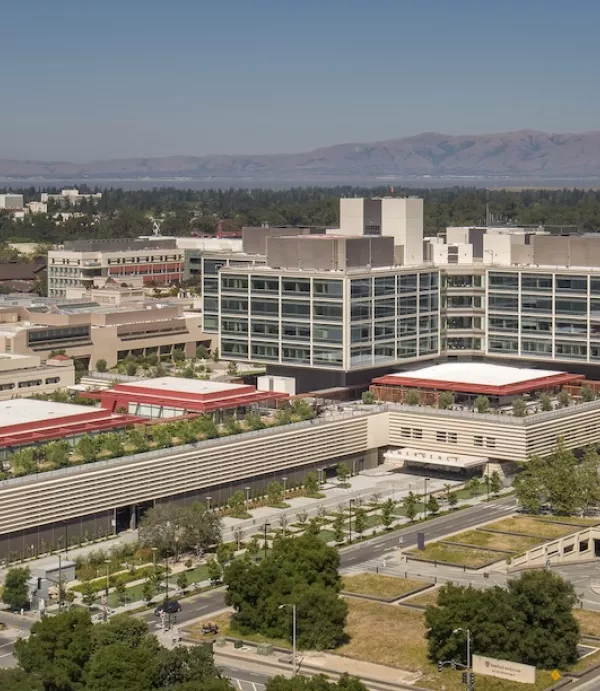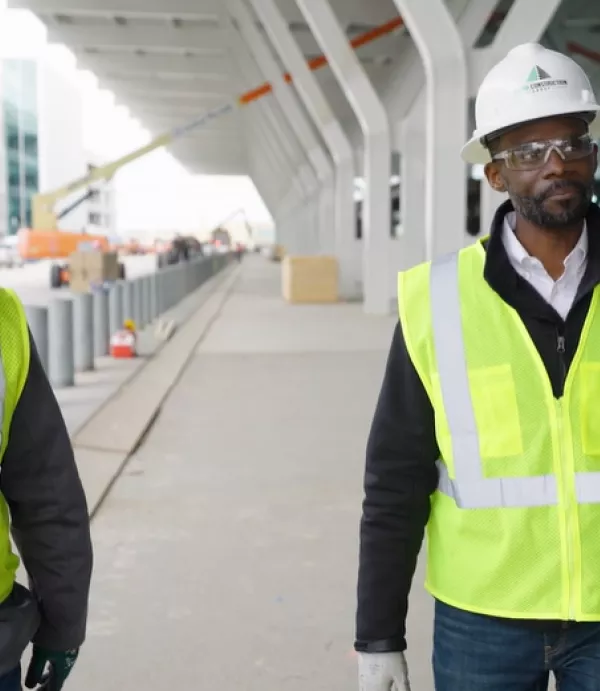The Playbook for Success at Chase Center
December 11, 2018

San Francisco's Mission Bay neighborhood is abuzz with activity: nine construction projects are currently underway in the up-and-coming med-tech hub, and the Bay Area’s most highly-anticipated development—Chase Center—is at the heart of the action. Designed as an epicenter for sports and entertainment, this 18,000-seat arena will serve as home court to the back-to-back NBA Champions Golden State Warriors and more than 200 additional events annually, including family shows, concerts, conventions, cultural and community events, and more. The iconic venue anchors an 11-acre site that also includes two 11-story office buildings, 29 unique retail locations, 3.2-acres of publicly-accessible plazas and open space, as well as a 900-space, below-grade parking structure.
Clark is working alongside joint venture partner Mortenson Construction to deliver the colossal development in time for the 2019-20 NBA season. As the game clock winds down, the project team is laser-focused on a strong finish and working at an unprecedented speed to guarantee success—a feat that entails 1,250 craftworkers putting in place $2.3 million of work per day. To the casual observer, the flurry of activity on site may appear chaotic, but just the opposite is true—every detail, every operation, and every sequence has been meticulously choreographed to ensure brilliant execution. Central to that effort is an intensely driven team of building professionals and a jobsite culture rooted in safety planning, preparation, collaboration, and innovation. Throw in a robust 4-Dimensional Synchro model, and comprehensive project playbook, and you have the secret sauce behind the project’s success to date.

While Chase Center is on track for an on-time completion, the project is anything but typical. “From its cutting-edge design, to the intricacies of its urban site, to the sequencing and pace of construction, this is one of the most complex operations I’ve ever been a part of,” notes Vice President Vic Watson, who has been involved with the job since its infancy. The 11-acre development, which is comprised of five unique structures supported by a shared podium, is bound by the San Francisco Bay to the east, academic housing for the UCSF Medical Center to the west, and active construction projects to the north and south. Adding to the project’s challenging site conditions is the land on which it sits—a marshy soil known as “Bay Mud,” which is partially comprised of rubble from the 1906 San Francisco earthquake. The arena’s sophisticated design, which features little repetition, also enhances its complexity. “With so many variables, we knew this wouldn’t be a straightforward approach,” recalls Watson when asked about the team’s early efforts to plan the job.
To tackle the herculean task, Watson and his colleagues thoughtfully analyzed and planned the Chase Center project for nearly four years—an endeavor that began in the project’s pursuit phase and intensified during a two-year preconstruction effort. Those preliminary work sessions were the genesis of several important project management tools, including a 4D model and a project playbook, which have been fundamental to the team’s planning efforts.

After an extensive evaluation of the project during preconstruction, the Chase Center team determined the only way to move the schedule forward effectively was to break the job into manageable pieces with separate schedules. “We spent a significant amount of time understanding how the various components of the job interconnected,” said Brian Nahas, VDC Manager. The team’s plan involved unraveling the arena from other structures on site and sequencing construction around its four structural cores: A, B, C, and D. The approach was initially outlined in a simple sketch, which depicted a specialized shoring solution that broke apart the project and detailed the progression of work, starting from the B Core and moving around the arena in a clockwise motion at each level simultaneously. Under this methodology, each quadrant of the arena had its own schedule for concrete and steel, and each level had its own schedule for mechanical, electrical, plumbing, and finish work. The team’s approach ensured that all levels of a quadrant were progressing at the same time, in the same direction, a task that required trade partners to provide multiple teams on site to ensure work progressed as planned around the arena bowl. While this approach intensified coordination and sequencing, it also allowed the project to progress unimpeded and at the quickest rate possible.
What started as a simple sketch quickly became an incredibly important tool forcommunicating the team’s approach to trade partners. “We made a point to map out the job very early on so that we could communicate the flow and schedule to trade partners long before we purchased major trades,” recalls Watson. “That sketch was the start of countless conversations. I think I drew it 1,000 times early on so that everyone could understand the sequence of work, and the shoring solution we needed to put in place to build the job in the most efficient way possible.”
Once the team established the proper workflow, they evolved the sketch into a 4D model, which they used to validate their approach. “With so many of the project components interconnected, we needed to ensure we had the right stagger between the arena, office buildings, gatehouse, and mixed-use elements,” notes Nahas. “The model allowed us to verify that our plan was executable and get everyone on board well in advance of construction.” By the time the team awarded contracts to key trades, every critical partner had walked through the sketch and the model. “Our goal was to ensure there were no surprises,” adds Watson. “Because of our early leg work, we were confident in our plan and ready to hit the ground running when it came to executing work in the field.”
As the team focused on maximizing productivity and ensuring quality and safety on site, the model continued to serve as a platform for collaboration with project partners. Coordination meetings led by Mortenson | Clark often included a cross-section of more than 40 industry professionals, including VDC experts, superintendents, design-assist trades, design managers, detailers, engineers, and architects, all working in the model. “Having key stakeholders from different disciplines working together in the model has yielded tremendous value by helping us not only progress the design but resolve potential roadblocks long before they became problems on site,” notes Superintendent Doug Jagoda.
Another tool that is vital to the team’s planning effort is a comprehensive project playbook. This 200-page schedule details 24,000 construction activities—every step needed to finish the job and hand over the keys. Similar to the sequencing sketch, the playbook was conceived during the pursuit phase as a lollipop schedule outlining big buckets of workflow. Over the last 19 months, a team of superintendents and scheduling professionals has driven logic into every line of the plan, analyzing and evaluating production rates, timeliness, and schedule disruptions, then modifying the plan to mitigate impacts in order to remain on track. Two and a half years after the playbook originated, the job is on schedule to the day.

While the Chase Center team is leveraging tools like the 4D model and project playbook, it is the people behind those efforts who drive the culture of planning. “We see these tools as a means to heighten safety, collaboration, productivity, and quality, but you have to have the right culture in place to support them, otherwise the job will falter,” states Nahas. He adds, “We made a point to establish that culture from day one.”
In many ways, construction is like basketball: it takes tremendous practice off the court and a deeply dedicated team—all pulling in the same direction—to realize success at game time. As the Chase Center team enters the second half of the game, their focus on ensuring that every detail is thoughtfully planned and executed remains steadfast. Jim McLamb, project director in charge of Chase Center’s construction operations, notes, “We are building a new home for a team that is known for their relentless pursuit of excellence. If we don’t apply that same level of passion and intensity to this job, it just wouldn’t feel right.”


